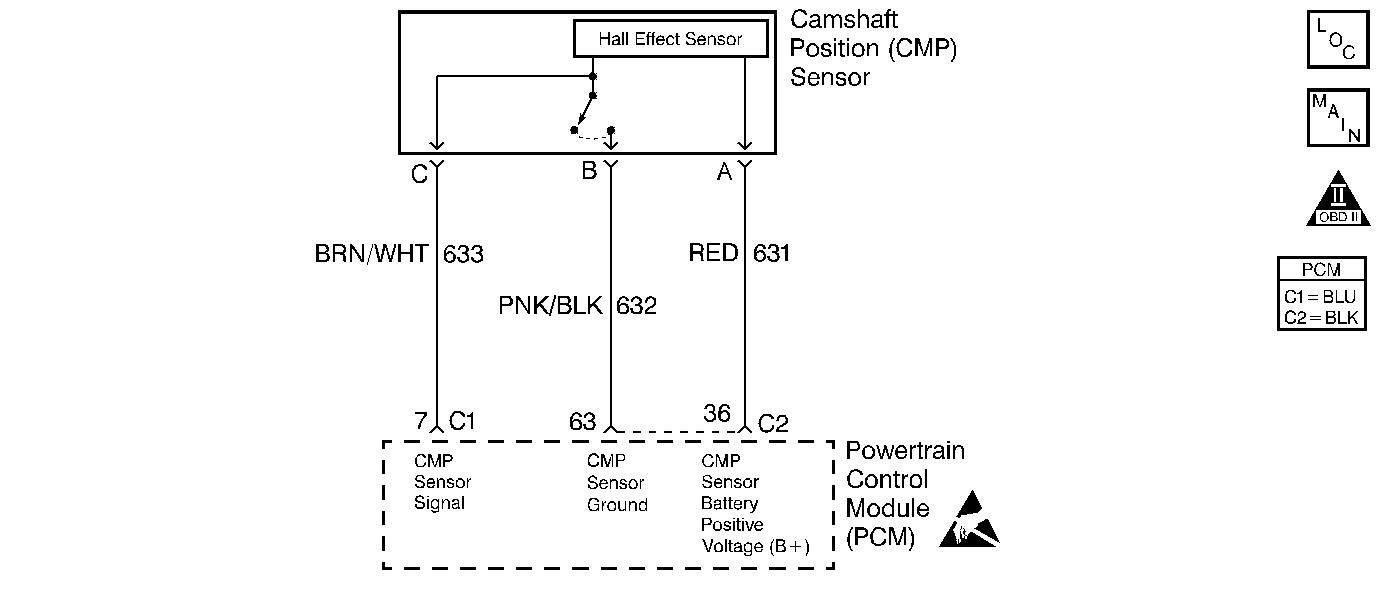
Circuit Description
The camshaft position (CMP) sensor indicates the camshaft position so the powertrain control module (PCM) can determine which cylinder is misfiring when a misfire is present. Whenever the PCM receives an intermittent signal from the CMP, then the CMP actrivity counter will increment. In order to set a DTC, the PCM must see a minimum number of resyncs within a maximum time.
Conditions for Running the DTC
The engine is running.
Conditions for Setting the DTC
The CMP Active Counter is not incrementing.
Action Taken When the DTC Sets
| • | The control module illuminates the malfunction indicator lamp (MIL) if a failure is detected during 2 consecutive key cycles. |
| • | The control module sets the DTC and records the operating conditions at the time the diagnostic failed. The failure information is stored in the scan tool Freeze Frame/Failure Records. |
Conditions for Clearing the MIL or DTC
| • | The control module turns OFF the MIL after 3 consecutive drive trips when the test has run and passed. |
| • | A history DTC will clear if no fault conditions have been detected for 40 warm-up cycles. A warm-up cycle occurs when the coolant temperature has risen 22°C (40°F) from the startup coolant temperature and the engine coolant reaches a temperature that is more than 70°C (158°F) during the same ignition cycle. |
| • | Use a scan tool in order to clear the DTCs. |
Diagnostic Aids
| • | Thoroughly check all circuitry for proper mating, broken locks, improperly formed or damaged terminals, or physical damage to the wiring harness. |
| • | Whenever the PCM sees less than 15 resyncs in 256 seconds, the counter resets to 0. Anytime a poor connection is present, the Cam Sensor Reference Activity counter stops incrementing and the Cam Sensor Resync Counter starts to increment. |
An intermittent may be caused by any of the following conditions:
| • | A poor connection |
| • | Rubbed through wire insulation |
| • | A broken wire inside the insulation |
Thoroughly check any circuitry that is suspected of causing the intermittent complaint. Refer to Intermittents and Poor Connections Diagnosis in Wiring Systems.
If a repair is necessary, refer to Wiring Repairs or Connector Repairs in Wiring Systems.
Test Description
The numbers below refer to the step numbers on the Diagnostic Table.
-
The Powertrain OBD System Check prompts you to complete some of the basic checks and to store the freeze frame and failure records data on the scan tool if applicable. This creates an electronic copy of the data captured when the malfunction occurred. The scan tool stores this data for later reference.
-
This step determines if the DTC P0342 is the result of a hard malfunction or an intermittent condition.
-
This step determines if the voltage is available to the CMP sensor through the PCM.
-
This step determines if the voltage is available to the CMP sensor through the PCM.
-
This step checks for a signal from the CMP sensor. It is necessary to supply B+ to the CMP sensor ignition positive voltage terminal in order for the CMP sensor to have B+ supplied to the CMP sensor. While cranking the engine, the CMP sensor will send a varying voltage signal that can be read by the DMM as a frequency check.
-
Program the replacement PCM and perform the Crankshaft Position System Variation Learn Procedure. Refer to the latest Techline procedures for PCM programming
Step | Action | Value(s) | Yes | No | ||||
|---|---|---|---|---|---|---|---|---|
Did you perform the Powertrain On-Board Diagnostic (OBD) System Check? | -- | |||||||
Is the CMP active counter incrementing? | -- | |||||||
3 |
Is the CMP active counter incrementing? | -- | ||||||
Did the test lamp illuminate? | -- | |||||||
Did the test lamp illuminate? | -- | |||||||
6 |
Was a repair necessary? | -- | ||||||
Does the DMM display a frequency reading that is varying between the specified values? | 0.5-2.6 Hz | |||||||
8 |
Was a repair necessary? | -- | ||||||
9 |
Does the test lamp illuminate? | -- | ||||||
10 |
Does the test lamp illuminate? | -- | ||||||
11 |
Was a repair necessary? | -- | ||||||
12 |
Is the action complete? | -- | -- | |||||
13 |
Is the action complete? | -- | -- | |||||
14 |
Is the action complete? | -- | -- | |||||
Is the action complete? | -- | -- | ||||||
16 |
Does the scan tool indicate that this diagnostic has ran and passed? | -- | ||||||
17 | Check to see if any additional DTCs are set. Does the scan tool display any DTCs that you have not diagnosed? | -- | Go to the applicable DTC table | System OK |
